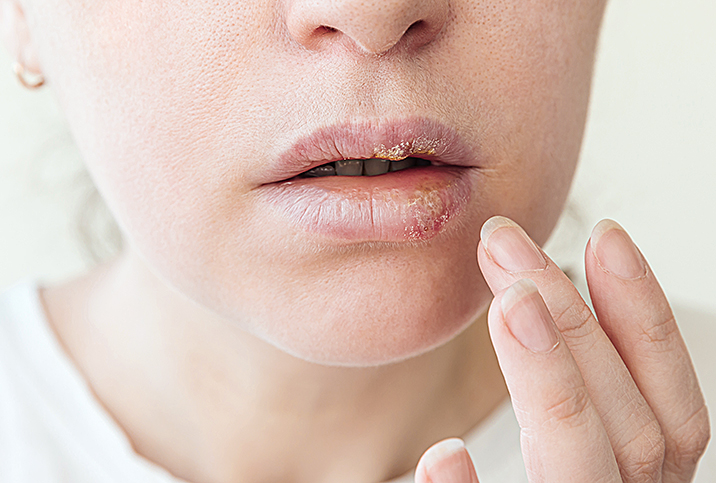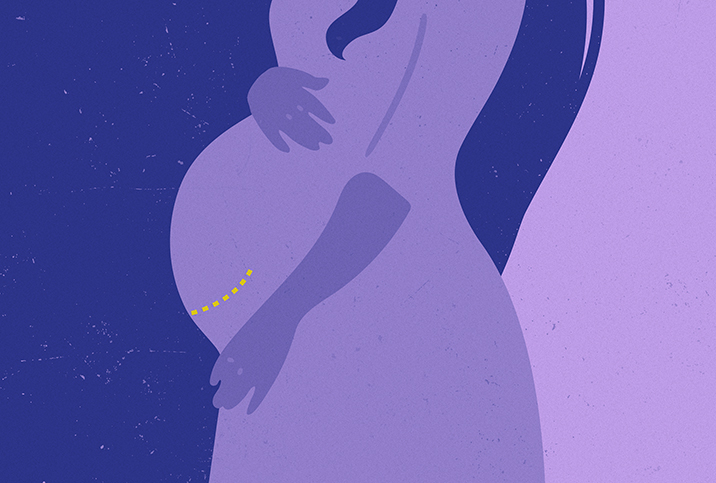What a Herpes Outbreak Looks Like for Women

While herpes is across-the-board uncomfortable, the infection can vary by individual and looks different in a vagina than it does on a penis. Whichever the case, knowledge is power, and understanding how herpes can affect you is the first step.
A herpes outbreak can feel a lot shorter and less intimidating when you know what phase you're currently in. Of the five stages of herpes, the first two are the first outbreak and the latent stage, when the body appears to return to a pre-herpes state. The remaining three stages all belong to the latter half of a herpes infection which takes much longer but is far less severe.
Herpes shouldn't cause unusual discharge
Herpes simplex virus (HSV-1) usually causes oral herpes, while HSV-2 usually causes genital herpes.
During a recurrent herpes outbreak, an individual progresses through three different stages. While either strain of herpes manifests similarly for both genders, women must take a few additional details into consideration.
However, that shouldn't include unusual discharge, according to Laura Purdy, M.D., a physician in Brentwood, Tennessee, and medical director at Wisp, a sexual healthcare company.
"HSV-2 is a condition of the skin," Purdy explained. "It should not be associated [with] any discharge at all. However, it is common for people to have more than one STI at a time, so if you are experiencing discharge, I would recommend that you check in with your doctor for testing to see if there are any other infections ongoing."
Symptoms can be overwhelming, but the herpes virus contributes only open sores, never strange or malodorous discharge. If such symptoms begin, these are distinct from your herpes outbreak and require medical attention.
Unusually painless sores also necessitate a trip to see your healthcare provider, added Ken Perry, M.D., a Charleston, South Carolina-based emergency physician and medical director at TeamHealth.
"HSV-2 virus lives on the nerve endings. This means that as the virus traverses the nerve in the way to the skin, it can be associated with pain," Perry explained. "Some [people] have much less sensitive nerves and may not feel the pain as early. HSV-2 lesions are painful, and if a patient has a lesion that looks like HSV-2 and it is not painful, then another cause should be evaluated."
Herpes and pregnancy
If you are pregnant or trying to become pregnant and have HSV-1 or HSV-2, Perry said your herpes care will be integrated into your neonatal care and delivery plan.
"If a patient has HSV-2, antiviral medications should be started at 36 weeks to suppress outbreaks," Perry advised. "If a patient has an outbreak, either primary or recurrence, cesarean section is the necessary delivery method to keep the baby from getting infected."
Antivirals are prescribed in hopes of facilitating a vaginal birth, but a C-section is necessary if any lesions are present. As lesions could potentially nest in the mucous membrane of the cervix, an extra step to consider is asking for a cervical swab to be performed a few days before birth and tested for herpes. This way, your cervix will not have completely ripened and, hopefully, can be kept from potentially contaminating the baby if the results are positive.
The best way to prevent or limit transference is to understand the timeline of a herpes outbreak.
The first outbreak
There are two types of first outbreaks in herpes: primary and nonprimary. A primary first outbreak is the first infection the individual has ever experienced with either strain of herpes. A nonprimary first infection means the individual has now acquired both strains of herpes. Perry contrasted the first and subsequent outbreaks.
"For the first outbreak, there are usually red spots around the genitals," Perry explained. "These will then develop into…flat, painful, white vesicle-like lesions. For subsequent outbreaks, the lesions are not all over the genitals but limited to one area."
While the first outbreak is the most severe and includes flu-like symptoms, this stage eventually gives way to the latency stage. During the latency stage, the body returns to its normal health and appearance. This is only temporary.
The prodrome stage
Only half of all people with herpes actually experience a prodrome stage, which is the body's warning that an outbreak is on the horizon in the form of tingling, numbness or pain in the lower back and upper thighs. Prodrome is the opportune time to commence medication to expedite the outbreak, but Purdy explained this undertaking is optional.
"Many people choose to take antivirals to help resolve the infection quickly," Purdy said. "However, this is actually a self-resolving virus which would clear up even if someone did not take medication. The natural life cycle of the outbreak is between one-and-a-half to two weeks untreated."
During that time frame, a person experiences the blister and ulcer stage of a herpes outbreak.
The blister/ulcer stage
During the blister and ulcer stage, the herpes outbreak becomes visible to the naked eye. Purdy outlined the basic trajectory that follows.
"The typical course is pain, tingling or numbness in the area, followed with an outbreak of one or a few blisters in the following days," Purdy said. "The cluster of blisters, which we call vesicles, may enlarge over the first couple of days of the outbreak."
Perry stressed the importance of heightened sanitary practices during this stage.
"HSV-2 infects the entire perineum. The best options would be to keep the area clean but to not contaminate areas that are not infected," Perry advised. "The ulcers have active virus emanating from them and can cause local spread in some cases. This may contaminate undergarments, and covering the lesions will keep viral particles from being aerosolized."
The perineum is the area between the genitals and the anus. The main difference in herpes for women and men, neonatal measures aside, is that a man's genitals are much more distanced from their anus than a woman's. This makes the female perineum particularly important during a herpes outbreak.
Your main objective during this active phase is to keep blisters clean, dry and covered. The greatest threat to the blister's sterility is you; avoid touching the sores and certainly don't fidget with or pick at them.
Purdy described how a patient knows they're approaching the end of their outbreak.
"Patients who have an active outbreak have to have the lesions improve visually," she explained. "The lesion will be crusted over and not painful. Virus particles are still released while the lesion is open."
The healing stage
Once lesions have visibly scabbed over and become painless, protection should still be practiced, but the outbreak is effectively over for the time being. After the first year of recurrent outbreaks, herpes typically becomes less and less frequent.
Keep in mind that your immune system has just weathered a beating; now is the time to be gentle with yourself and practice any self-care you would to avoid a cold or flu.

















